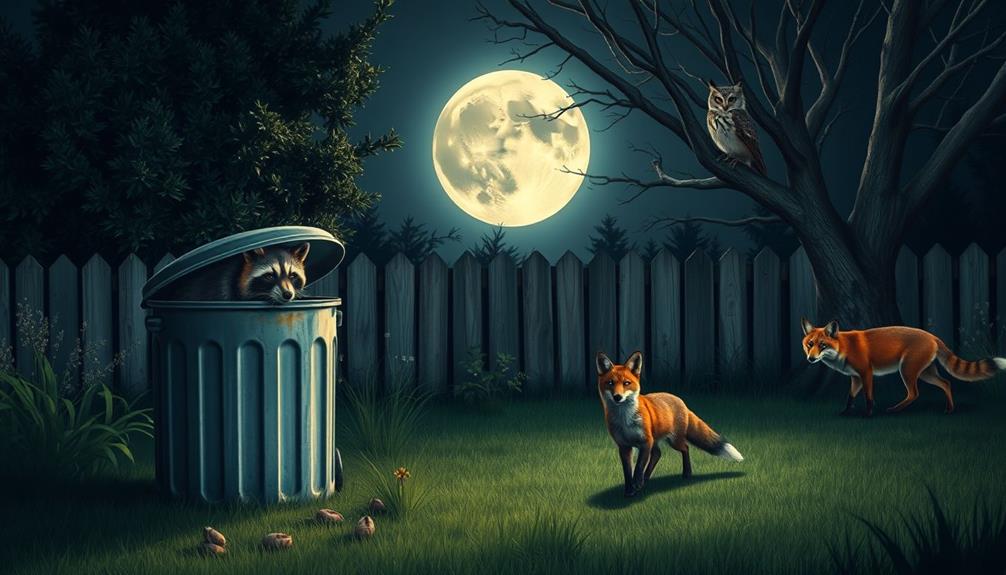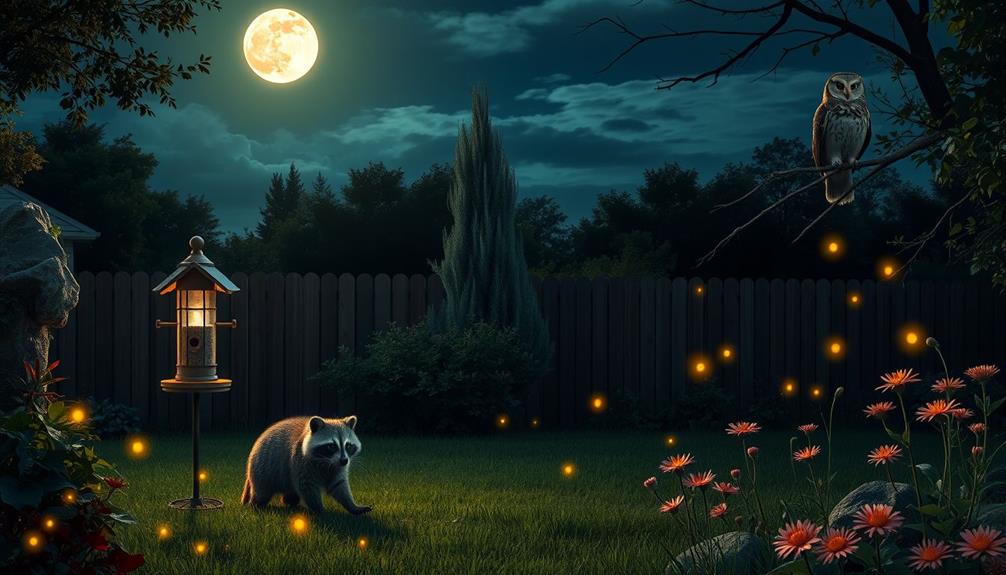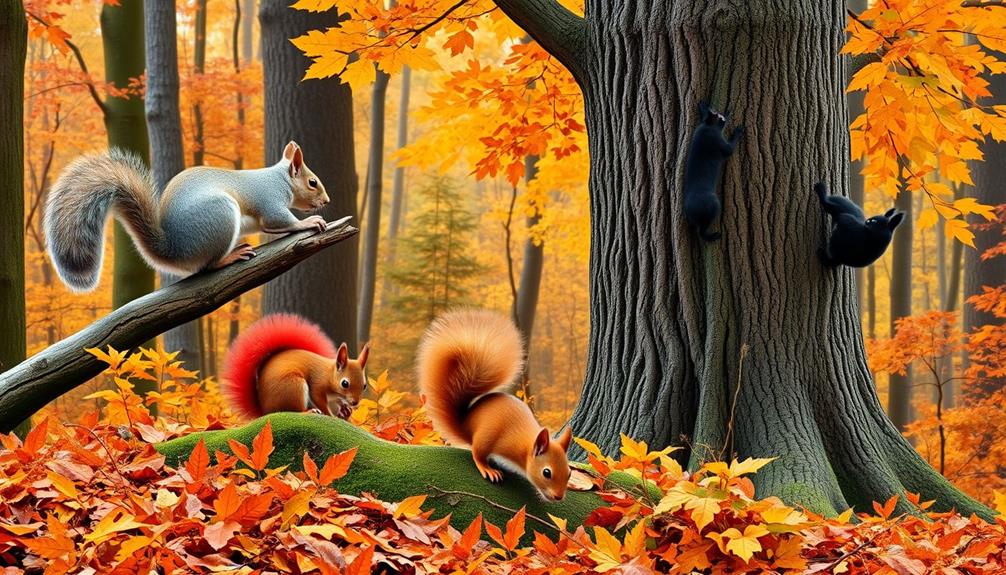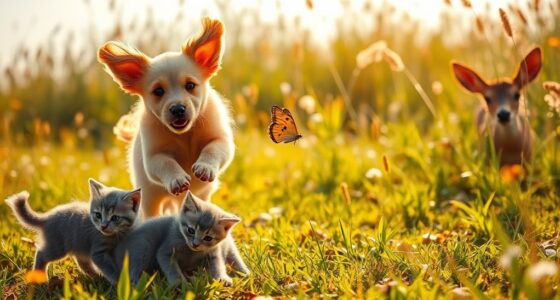When you explore your backyard at night, you might encounter fascinating nocturnal animals like raccoons, opossums, and owls. These creatures have adapted with keen senses and unique hunting strategies, allowing them to thrive in low-light conditions. Raccoons use their dexterous paws to forage, while owls rely on silent flight for hunting. Urbanization has impacted their habitats, making it essential to observe them safely and responsibly. By minimizing outdoor lighting and providing natural spaces, you can attract these night-time visitors. Stick around, and you'll discover more tips and insights about the incredible wildlife that comes alive after dark.
Key Takeaways
- Common nocturnal animals in backyards include raccoons, Virginia opossums, and great horned owls, each with unique adaptations for night-time survival.
- Nocturnal species rely on heightened senses, like hearing and smell, as well as adaptations such as large eyes for improved night vision.
- Urbanization impacts nocturnal wildlife by fragmenting habitats, increasing conflicts with humans, and disrupting natural behaviors due to artificial lighting.
- Observing nocturnal animals can be done safely with motion-activated cameras, minimal noise, and by using red or green lights to preserve night vision.
- Engaging in community conservation efforts helps protect nocturnal ecosystems and promotes awareness of the importance of these unique species.
Understanding Nocturnal Adaptations
Understanding the fascinating adaptations of nocturnal animals reveals how they've evolved to thrive under the cover of darkness. These creatures, like owls and bats, have developed large eyes and specialized retinas that enhance their night vision, allowing them to navigate effectively in low-light conditions.
When you're outside at night, you might notice how these animals are active at night, utilizing their adaptations to forage and hunt. Remarkably, many nocturnal species, like cats, also exhibit unique behaviors that reflect their emotional connections with their environments and the creatures around them, including their affinity for certain smells and textures, which can impact their activities during the night emotional attachment in cats.
Many nocturnal species possess heightened senses of hearing and smell, which help them detect predators and find food. For instance, owls can hunt silently, thanks to their unique feather structure, while bats use echolocation to navigate and locate their prey in total darkness.
The tapetum lucidum, a reflective layer behind their retinas, gives them an additional advantage by improving their ability to see in dim light.
These nocturnal adaptations not only aid in survival but also help these animals avoid contact with humans. By being active when most people are asleep, they minimize competition with diurnal species and make the most of the resources that are abundant at night.
This intricate balance showcases the incredible ways nature has equipped these animals for life in the dark.
Common Backyard Nocturnal Species

As night falls, your backyard may come alive with a variety of nocturnal species that have adapted to thrive in darkness. Raccoons often visit, using their dexterous paws to rummage through trash bins for food scraps.
These clever nocturnal animals are adept at finding meals in urban settings, much like how certain dogs are known for their resourcefulness in various situations, such as tough dog names suggested for strong personalities.
You might also spot Virginia opossums, North America's only marsupial, foraging at night. They consume a diverse diet, including insects, fruits, and small mammals.
Another fascinating visitor is the Southern flying squirrel, which glides gracefully between trees, primarily feeding on nuts and fruits. Their adaptation to nocturnal life is truly remarkable.
Owls, particularly the Great Horned Owl, are apex nocturnal predators, utilizing silent flight and exceptional night vision to hunt for small animals like mice and birds.
In more urban environments, skunks and armadillos increase their nighttime activity to avoid human encounters while searching for insects.
Each of these nocturnal creatures plays a unique role in your backyard ecosystem, contributing to the vibrant tapestry of life that unfolds under the cover of darkness.
Keep an eye out; you never know what you might encounter!
Nocturnal Feeding and Hunting Strategies

When darkness blankets your backyard, nocturnal animals spring into action, employing a variety of feeding and hunting strategies to thrive. These adaptations help them locate food sources and hunt at night when competition is often lower.
| Animal | Hunting/Feeding Strategy |
|---|---|
| Owls | Use silent flight and acute hearing to find prey in low-light conditions. |
| Bats | Utilize echolocation to navigate and detect insects in complete darkness. |
| Raccoons | Leverage dexterous front paws to manipulate objects and forage in groups. |
| Nightjars | Camouflage with cryptic plumage and catch insects while flying silently. |
| Virginia Opossum | Exhibit opportunistic feeding habits, consuming a variety of foods based on availability. |
These nocturnal creatures have evolved remarkable skills to secure their meals. For example, owls can silently swoop down on unsuspecting prey, while bats emit high-frequency sounds to spot insects in total darkness. Raccoons often forage together, boosting their chances of finding food sources. Nightjars glide through the air, catching insects with their large mouths, and opossums adapt their diets seasonally, ensuring they always have something to eat.
Social Structures of Nighttime Animals

Nocturnal animals exhibit captivating social structures that influence their survival strategies. For instance, raccoons often forage in groups, using their dexterous front paws to manipulate objects and access food sources more efficiently. This social behavior enhances their foraging strategies, allowing them to thrive in their environments.
Interestingly, social dynamics are also fundamental in the context of animal care, as understanding these interactions can impact how we support wildlife in urban settings, similar to how mental health support is essential for those at risk of dementia.
On the other hand, Virginia opossums are generally solitary, showcasing unique social dynamics among North American marsupials, particularly during mating season when they may interact more.
Red foxes present another example of social structures at play. They typically form family units, where parents and young collaborate to establish and defend territory while foraging for food together. This cooperative behavior is crucial for their success.
In contrast, nocturnal species like civets tend to be solitary, relying on keen senses to maintain their territories without social interaction.
These varied social structures among nighttime animals demonstrate the adaptability of their foraging strategies. Whether active at dusk in groups or alone, each species has evolved unique methods for survival, underscoring the complexity and richness of nocturnal wildlife in your backyard.
Understanding these dynamics can enhance your appreciation of the night-time ecosystem.
Impact of Urbanization on Wildlife

Urbanization greatly impacts wildlife, particularly nocturnal species that struggle to adapt to rapidly changing environments. As cities expand, habitat fragmentation restricts the movement and breeding of creatures like raccoons and opossums. This not only affects their populations but also their genetic diversity. Increased artificial lighting disrupts natural behaviors, altering foraging and mating patterns, while urban infrastructure increases mortality rates from vehicle collisions.
Here's a closer look at the effects of urbanization on nocturnal wildlife:
| Issue | Impact on Nocturnal Wildlife |
|---|---|
| Habitat Fragmentation | Limits movement and reduces genetic diversity |
| Artificial Lighting | Disrupts foraging and mating behaviors |
| Food Sources | Leads to reliance on human food, increasing conflicts |
| Urban Infrastructure | Increases vehicle collisions and mortality rates |
As these challenges mount, nocturnal animals often adapt by exploiting human food sources, resulting in heightened human-wildlife conflicts. The loss of natural cover and nesting sites further complicates their survival. Understanding these impacts helps you appreciate the resilience of nocturnal wildlife amidst urban growth.
Observing Nocturnal Animals Safely

Observing nocturnal animals can be a rewarding experience, but doing so safely is key. To enjoy the night while minimizing your impact on wildlife, consider using motion-activated cameras. These devices let you capture the active behaviors of nocturnal animals without disturbing them.
Additionally, ensuring your backyard is free from items that could cause harm, much like how flushing improper items can lead to plumbing issues, can create a safer environment for wildlife proper disposal methods.
When you venture out, keep outdoor lighting to a minimum. Excessive brightness can deter many species from visiting your backyard, robbing you of the chance to observe them.
Maintain a safe distance while watching these creatures; this not only keeps you safe but also reduces stress for the animals, especially those that might feel defensive, like skunks or raccoons.
Setting up feeding stations or natural habitats, such as brush piles, can help attract wildlife. Just remember to secure your garbage and food sources to avoid unwanted visitors.
When you're ready to observe, find a concealed spot and use binoculars or spotting scopes. This way, you can enhance your viewing experience while respecting wildlife's space.
Conservation of Nocturnal Ecosystems

Conserving nocturnal ecosystems starts with effective habitat protection strategies that guarantee these crucial areas remain intact.
Understanding the unique behaviors and needs of nocturnal animals, much like the rich cultural narratives found in Aboriginal art concepts, can enhance our conservation efforts.
You can get involved through community engagement initiatives that raise awareness and promote local conservation efforts.
Together, we can create a healthier environment for both nocturnal wildlife and ourselves.
Habitat Protection Strategies
Protecting nocturnal habitats is crucial for maintaining the delicate balance of our ecosystems. To support species like owls, bats, and raccoons, you need to focus on habitat protection by preserving natural vegetation that provides food and cover.
Implementing buffer zones around these areas can counteract the impacts of urbanization, helping to reduce habitat fragmentation and ensuring safe corridors for wildlife movement. Additionally, creating environments that mimic natural settings, such as those found in diverse landscapes can greatly benefit nocturnal species.
One critical aspect of this is addressing light pollution. Excessive artificial lighting disrupts the natural behaviors of nocturnal animals, affecting their hunting, mating, and foraging activities. By minimizing unnecessary outdoor lighting, you can create a more welcoming environment for these creatures.
Community engagement plays an important role in these efforts. Participate in habitat restoration projects, such as planting native species and designing wildlife-friendly landscapes. This not only enhances local ecosystems but also supports the diversity of nocturnal species.
Educating your community about the importance of nocturnal wildlife and the threats they face fosters a culture of conservation. By encouraging responsible behaviors, you can help protect their natural habitats from pollution and disturbance, ensuring a thriving ecosystem for years to come.
Community Engagement Initiatives
Community involvement is essential for the health of nocturnal ecosystems. By participating in wildlife monitoring programs, you can observe and report nocturnal animal activity, contributing valuable data to conservation efforts.
Understanding the importance of identifying edible vs. inedible plants can also enhance your appreciation of the ecosystems in which these nocturnal animals thrive. Educating yourself through workshops and events can deepen your understanding of species like owls, bats, and raccoons, which play critical roles in pollination and maintaining ecological balance.
Engaging in citizen science projects, such as nighttime wildlife surveys, allows you to help track the health and diversity of local nocturnal populations. Local conservation organizations often host night hikes and wildlife watching events, giving you a chance to appreciate the wonders of night skies and the wildlife that thrives under them.
Collaborating with schools and educational institutions can also enhance these initiatives. By integrating nocturnal wildlife studies into curricula, you can inspire younger generations to become stewards of their environment.
Each effort contributes to the conservation of nocturnal ecosystems, ensuring these animals continue to flourish. Together, you and your community can make a significant impact on the health of these crucial ecosystems.
Frequently Asked Questions
What Nocturnal Animals Do at Night?
At night, nocturnal animals hunt, forage, and socialize. They rely on keen senses, like echolocation and night vision, to navigate and find food, while also vocalizing for mating or territorial displays. You can observe their fascinating behaviors.
What Is the Most Known Nocturnal Animal?
When you think of nocturnal animals, the owl's likely the first that comes to mind. Its exceptional night vision and unique calls make it a symbol of wisdom and mystery in the dark.
What Are the Negatives of Being Nocturnal Animals?
Being nocturnal has its perks, like quiet nights, but it also means facing dangers. You encounter predators, struggle with light pollution, and compete for resources, making survival a constant challenge under the cover of darkness.
What Is an Animal That Is Most Active at Night?
When you think of animals most active at night, raccoons come to mind. They use their agile paws to rummage through gardens and trash, making them skilled foragers in urban environments under the cover of darkness.
Conclusion
As you explore your backyard at night, remember that these nocturnal creatures play an essential role in your local ecosystem, much like the knights of old defending their domain. By understanding their adaptations and needs, you can appreciate the hidden life around you. Take the time to observe them safely and advocate for their conservation. Your small efforts can make a big difference in preserving these fascinating animals and their habitats for future generations.










